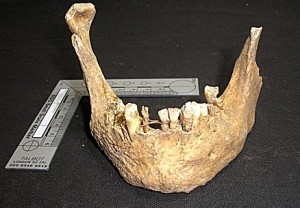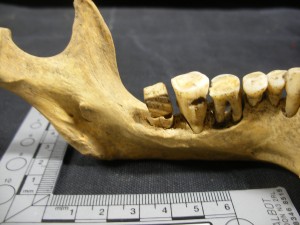There is archaeological evidence for dental procedures going back over 8000 years. In the middle ages in the UK dentists as we know them had not evolved as a profession. When people had dental problems they usually went to either a barber or a general physician, as was the case with many other medical problems. Practices were crude by modern standards, but the basic concepts of the causes of dental disease were starting to be understood. During the archaeological dig in the former East Kirk of St Nicholas, many of the human remains retained some teeth. In this post we are showing two examples where there had been some sort of dental work.
 In the first photograph a gold wire is fastened by twisting round a tooth (to the right) and is then looped round a peg (to the left). This burial dates from between the 16th and 18th century, but was ‘disarticulated’, meaning that it was not a complete skeleton, but part of a burial which had been disturbed by later gravediggers. Evidence from other sites show that these pegs could be made of wood or could be real teeth, presumably purchased from another individual. One is left to speculate about the motives and any remuneration involved in such instances. However, the supporting teeth are rotten, so the ‘patient’ may have been more comfortable had they been removed.
In the first photograph a gold wire is fastened by twisting round a tooth (to the right) and is then looped round a peg (to the left). This burial dates from between the 16th and 18th century, but was ‘disarticulated’, meaning that it was not a complete skeleton, but part of a burial which had been disturbed by later gravediggers. Evidence from other sites show that these pegs could be made of wood or could be real teeth, presumably purchased from another individual. One is left to speculate about the motives and any remuneration involved in such instances. However, the supporting teeth are rotten, so the ‘patient’ may have been more comfortable had they been removed.
 The second photograph is much earlier – between mid 12th and mid 15th centuries – and was only found during the detailed study of the human remains.. Exactly what was intended is not clear, but the jaw of this middle age adult has a sawed square of bone or ivory in a cavity in place of a tooth. Medieval texts indicate that dental treatment from this period was largely based on herbal remedies, charms and amulets. However, there are also references to dentures made of human or cow bone, which fits what is shown here. It can also be seen that the other teeth are in a very poor condition and there is an abscess as well, so this man would have had a lot of pain. As a result he would have gained little if any relief, so it could be that this ‘peg’ is being used as a charm rather than an actual attempt to have a false tooth.
The second photograph is much earlier – between mid 12th and mid 15th centuries – and was only found during the detailed study of the human remains.. Exactly what was intended is not clear, but the jaw of this middle age adult has a sawed square of bone or ivory in a cavity in place of a tooth. Medieval texts indicate that dental treatment from this period was largely based on herbal remedies, charms and amulets. However, there are also references to dentures made of human or cow bone, which fits what is shown here. It can also be seen that the other teeth are in a very poor condition and there is an abscess as well, so this man would have had a lot of pain. As a result he would have gained little if any relief, so it could be that this ‘peg’ is being used as a charm rather than an actual attempt to have a false tooth.
(The photographs are copyright Aberdeen Art Gallery & Museums Collections and are used with permission).